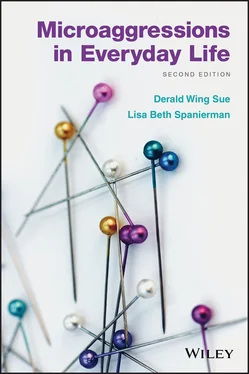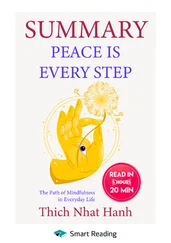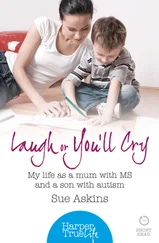The majority of work on microaggressions has focused on how they detrimentally harm target populations. In this new edition, we devote Chapter 6to how macrolevel systems of dominance and oppression affect the microlevel psyche and behavior of perpetrators or offenders. Interestingly, very little research has focused on understanding those who commit microaggressions. Thus, we address several important questions: Who are microaggressive perpetrators? How and why do individuals perpetrate microaggressions? What makes it so difficult for perpetrators to recognize their role in the transmission of microaggressions? What are the costs of microaggressions to those who perpetrate them? This last question is unique and important because most discussions of perpetrators emphasize power, privilege, and the advantages that accrue to dominant‐group members who engage in oppressive acts. We show, however, that research reveals microaggressors experience a multitude of psychosocial costs (emotional, behavioral, spiritual, and moral) that deplete their humanity.
Second, we also introduce a completely new concept in this edition that we label microinterventions . In our work with microaggressions, we have repeatedly asked how people can effectively fight against expressions of bias. In Chapter 10we review the literature and findings on antibias actions and develop a conceptual framework of strategies (microinterventions)—a repertoire of responses used to directly disarm or counteract the effects of micro‐ and macroaggressions by challenging perpetrators who deliver interpersonal slights and persons in authority who operate under biased policies or practices. In this chapter we describe the potential antiracist actions of three major groups— targets, allies, and bystanders— in their struggle against racism. We believe these constituents must take a proactive stance against the discriminatory actions of perpetrators. Drawing from research studies, we extract guiding principles and provide suggestions, strategies, and interventions that disrupt, diminish, or terminate prejudice and discrimination at the individual level. We also address the need for scholars and practitioners to develop antiracist microintervention strategies directed at biased institutional programs and practices and toward biased societal social policies as well.
Third, another major addition to the book is Chapter 7, “Researching Microaggressions: Show Me the Evidence,” and our stance that there are multiple ways to ask and answer questions about the human condition, especially in the study of microaggressions. Unlike some scholars who minimize the importance of experiential reality and targets’ perspectives, we believe that methodological diversity is necessary and must involve to some degree people's lived experiences. We provide a historical look at how the study of microaggressions has evolved over the years; the advantages and disadvantages of specific research strategies; and a description of both qualitative and quantitative methodologies used to portray a more comprehensive picture of the nature, manifestation, expression, and impact of microaggressions and how these aspects vary for different groups in different contexts. Of special relevance to future researchers, we provide an overview of more than a dozen microaggression scales commonly used to research these forms of bias.
Fourth, throughout the book we distinguish between the usage of the terms “microaggressions” and “macroaggressions.” In our earlier formulation of microaggression theory, we concentrated primarily on microassaults, microinsults, and microinvalidations. This led to confusion when some in the public began to use the term “macroaggressions” to indicate the immense harm that often resulted from a microaggression. Unlike microaggressions, which are situated in microlevel interpersonal contexts, macroaggressions affect whole groups or classes of people because they are systemic in nature. Further, micro aggressions reside in the beliefs and attitudes of individuals, while macro aggressions reside in the programs, policies, and practices of institutions and society. Disarming or counteracting microaggressions refers to neutralizing bigotry among individuals, whereas combating macroaggressions refers to changing the policies and practices of organizations and institutions that deny equal access and opportunity for all.
Fifth, being both educators and mental health practitioners, we introduce two completely revised chapters: Chapter 8, “Teaching About Microaggressions,” which has implications for educators, and Chapter 9, “Microaggressions in Counseling and Psychotherapy.” As it is nearly impossible to separate the practice of teaching about microaggressions from the dynamics of encountering microaggressions in the classroom, in Chapter 8we focus on teaching about microaggressions as well as using teachable moments effectively when microaggressions occur in our classrooms. In Chapter 9we underscore how clients’ presenting concerns may be related to microaggressive harm in their everyday lives. We also emphasize how well‐intentioned helping professionals unknowingly commit harmful microaggressions toward their clients in the therapeutic context, which is especially concerning because clients seek therapy to resolve problems. Culturally insensitive therapeutic practice can lead to secondary trauma, especially among clients who experience multiple microaggressions in their everyday lives. If microaggressions are not addressed in therapy or, worse yet, if a therapist commits microaggressions during a session, clients may never receive the help they need. In this chapter we describe briefly mental health disparities in terms of underutilization, premature termination, and quality of care. We also review cutting‐edge counseling process and outcomes research that investigates microaggressions in the therapy context.
Microaggressions in Everyday Life, Second Edition is divided into four major sections.
Section One—Psychological Manifestation and Dynamics of Microaggressionsis composed of three chapters that provide the conceptual framework of microaggression theory and explicate, via research, the manifestation, dynamics, and impact of microaggressions across a broad spectrum of marginalized group members.
Chapter 1—Microaggressions as Toxic Rain: Here, There and Everywhere!
What Are Microaggressions?
Racial MicroaggressionsThe Invisibility and Nebulous Nature of Everyday Racism
Gender Microaggressions
Sexual‐Orientation Microaggressions
Misunderstanding MicroaggressionsStop Making Mountains Out of Molehills!Everything’s a Microaggression in This Climate of Political CorrectnessYour Analysis Is Flawed
Microaggressions, Marginality, and Harmful Impact
The Way Forward: Making the “Invisible” Visible
Chapter 2—Taxonomy of Microaggressions
Conscious and Deliberate Bigotry versus Unconscious and Unintentional BiasThe Changing Face of Racism, Sexism, and HeterosexismMicroaggressions
Environmental Macroaggressions
Forms of MicroaggressionsMicroassults
Microinsults and Microinvalidations: Common ThemesMicroinsultsMicroinvalidations
The Way Forward: Defining, Recognizing, and Deconstructing Hidden Messages in Microaggressions
Chapter 3—The Psychological Dilemmas and Dynamics of Microaggressions
Clash of Racial Realities: “You Are Just Being Hypersensitive and Misreading the Situation!”
Invisibility of Unintentional Biases: “I'm Not a Racist!”
Perceived Minimal Harm of Microaggressions: “Don't Make a Mountain Out of a Molehill!”
The Catch‐22 of Responding to Microaggressions: “You're Damned if You Do and Damned if You Don't!”
Читать дальше












